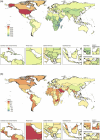Global and regional trends and projections of chronic pain from 1990 to 2035: Analyses based on global burden of diseases study 2019
- PMID: 39726775
- PMCID: PMC11669129
- DOI: 10.1177/20494637241310697
Global and regional trends and projections of chronic pain from 1990 to 2035: Analyses based on global burden of diseases study 2019
Abstract
Background: Chronic pain poses a significant public health challenge. We present the global and regional data on Prevalence, Incidence and Years Lived with Disability (YLDs) for Chronic pain from the Global burden of disease (GBD) study 2019 data and analyze their associations with Socio-demographic index (SDI), age, and gender, and the future trends from 2020 to 2035.
Methods: Regional trends in the burden of chronic pain and its association with age, gender, and SDI were assessed from 1990 to 2019. Joinpoint analysis was employed to describe trends in chronic pain burden across different SDI regions. Additionally, the Bayesian Age-Period-Cohort model (BAPC) was used for predicting future trends. Age-standardized rates (ASRs) of prevalence, incidence, and YLDs were employed to quantify the burden of chronic pain.
Results: Between 1990 and 2019, a significant increase was observed in global prevalence and YLDs rates of chronic pain. Higher rates were found among females, whereas a faster rise was noted among males. Notably, Low Back Pain (LBP) and Migraine accounted for predominant YLDs globally, particularly among those aged 75 and above. A notable prevalence of Tension-type Headache (TTH) was observed among younger populations. Furthermore, ASRs for chronic pain were highest in high-SDI regions. Projections suggest an increase in headache ASRs globally for both genders from 2020 to 2035.
Conclusion: From 1990 to 2019, the global burden of chronic pain increased significantly, with projections indicating a continued rise in headache burden over the next 15 years, underscoring the need for heightened attention to these issues.
Keywords: Bayesian age-period-cohort model; chronic pain; global burden of diseases study; headache; incidence; musculoskeletal disorders; prevalence; socio-demographic index; years lived with disability.
© The Author(s) 2024.
Conflict of interest statement
The author(s) declared no potential conflicts of interest with respect to the research, authorship, and/or publication of this article.
Figures





Similar articles
-
Global, regional, and national burden and trends of Low back pain in middle-aged adults: analysis of GBD 1990-2021 with projections to 2050.BMC Musculoskelet Disord. 2024 Nov 7;25(1):886. doi: 10.1186/s12891-024-08002-y. BMC Musculoskelet Disord. 2024. PMID: 39511565 Free PMC article.
-
Global, regional, and national burden of gout in people aged 15-39 years from 1990 to 2021: Trends, cross-country inequalities and forecast to 2035.Joint Bone Spine. 2025 May 26;92(6):105929. doi: 10.1016/j.jbspin.2025.105929. Online ahead of print. Joint Bone Spine. 2025. PMID: 40436105
-
Global burden of neck pain and its gender and regional inequalities from 1990 - 2021: a comprehensive analysis from the Global Burden of Disease Study 2021.BMC Musculoskelet Disord. 2025 Jan 31;26(1):94. doi: 10.1186/s12891-025-08331-6. BMC Musculoskelet Disord. 2025. PMID: 39891177 Free PMC article.
-
Global, regional and national burden of low back pain 1990-2019: A systematic analysis of the Global Burden of Disease study 2019.J Orthop Translat. 2021 Sep 10;32:49-58. doi: 10.1016/j.jot.2021.07.005. eCollection 2022 Jan. J Orthop Translat. 2021. PMID: 34934626 Free PMC article. Review.
-
The global, regional, and national burden of pancreatitis in 195 countries and territories, 1990-2017: a systematic analysis for the Global Burden of Disease Study 2017.BMC Med. 2020 Dec 10;18(1):388. doi: 10.1186/s12916-020-01859-5. BMC Med. 2020. PMID: 33298026 Free PMC article.
Cited by
-
Reconfiguring Pain Interpretation Within a Social Model of Health Using a Simplified Version of Wilber's All Quadrant All Levels Framework: An Integral Vision.Behav Sci (Basel). 2025 May 20;15(5):703. doi: 10.3390/bs15050703. Behav Sci (Basel). 2025. PMID: 40426481 Free PMC article.
-
Effects of cupping therapy on chronic musculoskeletal pain and collateral problems: a systematic review and meta-analysis.BMJ Open. 2025 May 28;15(5):e087340. doi: 10.1136/bmjopen-2024-087340. BMJ Open. 2025. PMID: 40441767 Free PMC article.
-
eHealth interventions for chronic pain: Protocol for a systematic review and meta-analysis.MethodsX. 2025 Jun 27;15:103475. doi: 10.1016/j.mex.2025.103475. eCollection 2025 Dec. MethodsX. 2025. PMID: 40678457 Free PMC article.
-
Analysis and comparison of the trends in burden of low back pain in China and worldwide from 1990 to 2021.J Health Popul Nutr. 2025 Feb 13;44(1):39. doi: 10.1186/s41043-025-00768-8. J Health Popul Nutr. 2025. PMID: 39948668 Free PMC article.
References
-
- Caraceni A, Martini C, Zecca E, et al. Breakthrough pain characteristics and syndromes in patients with cancer pain. An international survey. Palliat Med 2004; 18: 177–183. - PubMed
-
- Perrot S, Cohen M, Barke A, et al. The IASP classification of chronic pain for ICD-11: chronic secondary musculoskeletal pain. Pain 2019; 160: 77–82. - PubMed
-
- Treede RD, Rief W, Barke A, et al. Chronic pain as a symptom or a disease: the IASP classification of chronic pain for the international classification of diseases (ICD-11). Pain 2019; 160: 19–27. - PubMed
-
- Lyng KD, Djurtoft C, Bruun MK, et al. What is known and what is still unknown within chronic musculoskeletal pain? A systematic evidence and gap map. Pain 2023; 164: 1406–1415. - PubMed
LinkOut - more resources
Full Text Sources
Miscellaneous
